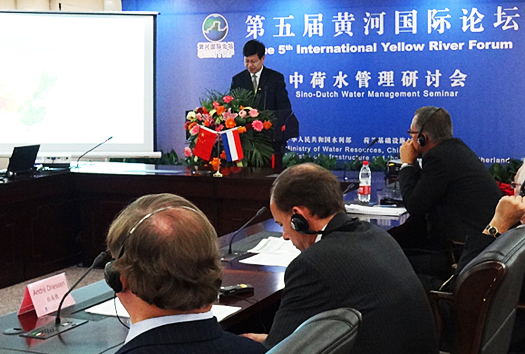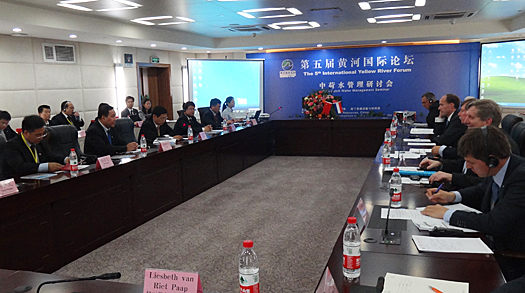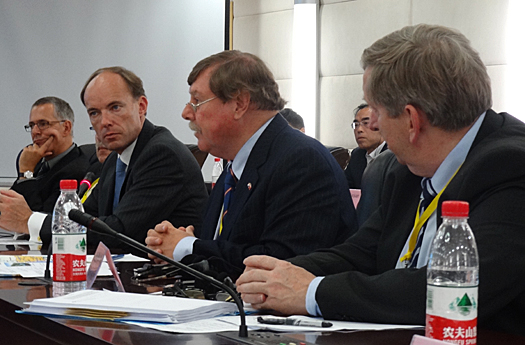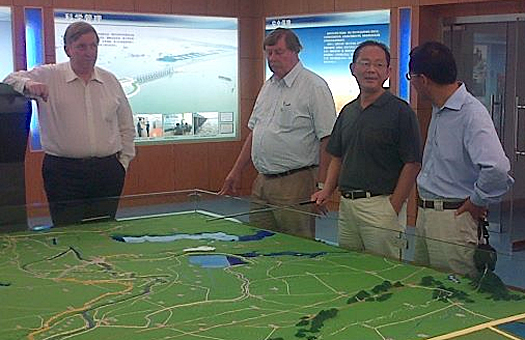5th Yellow River Forum: Joint Sino-Dutch development of new system to determine levee strength
The Chinese and Dutch participants of the Sino-Dutch Water Management Seminar at the Yellow River Forum in Zhengzhou, China agreed to start a joint research project for a new assessment system to determine the strength of a levee.
The seminar took place on September 26 and was chaired by Chinese deputy minister Hu Siyi of the ministry of Water resources and Dutch deputy director Ingwer de Boer of the ministry of Infrastructure and environment.
Reduction overdimensioning saves a lot of money
Many levees, especially those with both sand and clay layers, are overdimensioned to be certain about its strength. Especially the effects of piping can be devastating when seepage undermines sandy layers inside of beneath the levee. The seepage creates channels in the sand, eventually leading to erosion and finally to the collapse of the whole levee.
Experts at the seminar agreed that if more is known of the piping process and the strength of a levee can be assessed better, there is less need for overdimensioning. Because of the huge investments involved, the agreed joint research project can save a lot of money on future levee construction and maintenance.
The Chinese participants showed great interest in real scale tests at the Dutch test location for leeves, the IJkdijk. The tests with large scale piping generated unique new insights in the process of channeling, erosion and real failure.
(read more: New tests IJdijk: breaches predictable with new sensor systems – September 13, 2012)
Comparing data to improve flood predictions
The participants of the Sino-Dutch seminar also discussed the progress of the joint Huaihe-Rhine river basin project. The Chinese river authorities have now implemented the Delft FEWS early flood warning system. This enable to compare the predictions for flooding on both the river Rhine and Huaihe.
By collecting real experiences from both rivers it will be possible to futher reduce the uncertainty margins of river flood prediction models.
(read more: Dutch and Chinese authorities start sharing information on Rhine and Hauihe river basin programme – November 22, 2011)
Large scale flood retention areas
The Dutch experts showed great interest in a large flood retention area along the Huaihe river. Some 160.000 people live in the area that floods with an average of once every two or three years. The villages are protected by ring dikes and houses are built on mounds. During the seminar experiences were exchanged on the warning systems, financial compensation for flood damage, and legal aspects.
The Dutch interest originates from a comparable flood retention area in the Netherlands , the Overdiepse polder, that is currently under construction. The reconstruction of this polder is part of the ‘Room for the river’ programme, comprising over 30 projects along the Rhine river.
The Dutch Room for the river programme is scheduled for completion in 2015, increasing the discharge capacity of the Rhine from 16.000 to 18.000 cubic meters. Total costs of the programme are 2,3 billion euro.
(read more: First dairy farmer moves to new farm on 6m high mound in Overdiepse polder – August 11, 2012)
Dutch delegation leader Ingwer de Boer (second left) and coordinator Gerard de Vries (left) for the Sino-Dutch programme informed about the flood retention area of the Huaihe river.
More information
Ministry of Water Resources
Beijing, China
+41 86 10 6320 2557
www.mwr.gov.cn
Ministry of Infrastructure and environment/Rijkswaterstaat
The Hague, the Netherlands
+31 70 351 80 80
www.rijkswaterstaat.nl
Huaihe River Commission
Bengbu, China
+41 86 552 309 37 19
www.hrc.gov.cn
Rijkswaterstaat Room for the river
Programme Directorate
Utrecht, the Netherlands
+ 31 88 797 2900
www.ruimtevoorderivier.nl
IJkdijk Foundation
Groningen, the Netherlands
050 521 44 66
www.ijkdijk.nl








